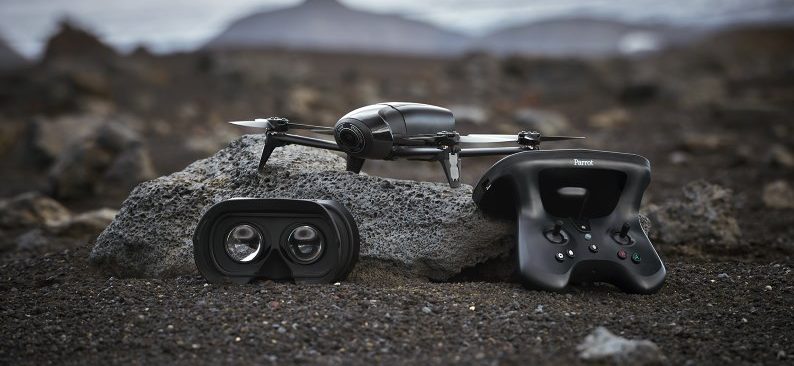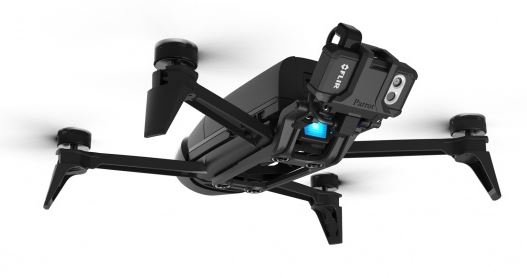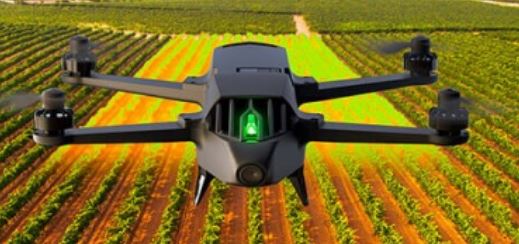Parrot recently released a couple of new drones to the public. Everyone was excited about it, especially drone enthusiasts. Could it be that Parrot is releasing a successor to Bebop 2? Maybe with a built-in 4k camera? That’s been something that many drone fans have been expecting.
What Parrot unveiled was actually something completely different. They decided to diversify their assortment of drones by releasing two professional grade drones, Parrot Bluegrass and Parrot Bebop-Pro Thermal.
Who is Parrot exactly?
We don’t feature drones from Parrot that often here, mainly because they don’t release new models that often. Last one we’ve taken a look at was Bebop-Pro Thermal. Parrot is a French electronics company which was started all the way back in 1994. They obviously didn’t start making drones in 1994, no.
First drone that Parrot released was back in 2010. Since then they released some very popular models of drones like Bebop and Bebop 2. Their drones are considered high end and are a direct competitor to the Chinese drone manufacturer DJI, probably the most famous drone maker out there.
Parrot drones can usually be purchased for cheaper than DJI drones can, at least drones that have similar specifications. What’s more, Parrot drones like Bebop 2 are in some aspects better than DJI drones from similar price segments. They have good battery life, excellent transmitter range, FPV and even things like VR.
One small drawback of Parrot drones, in the eyes of extreme drone enthusiasts, would definitely be the lack of a 4k camera. That’s why many people prefer DJI, or at least that’s my theory. It could also be that DJI is more popular because of far better mindshare that it has. In any case, something is causing people to ignore Parrot when buying drones and that’s causing a lot of problems for them.
What is happening over at Parrot?
News that Parrot is slowly shifting its focus to developing drones for professional application shouldn’t really surprise anyone. We saw hints of this happening earlier this year with their release of Parrot Bebop-Pro 3D Modeling, a drone that can create 3D models out of houses, for example, using specialized camera sensors and software.
Another piece of news about Parrot that you might have missed is that Parrot has been cutting down jobs in their drone department. In January this year, one third of their drone staff was laid off. That’s around 290 jobs which had to be terminated due to not so good quarterly financial reports. Fierce competition from DJI has taken its toll on the profit margins of Parrot, and they had to find a new way how to stay afloat.
One way how they decided to do that was to extend their focus from the commercial to the professional segment of the market. Parrot Bluegrass and Parrot Bebop-Pro Thermal are the result of that shift in focus.
Bebop-Pro Thermal – thermal imaging drone for professionals
One of the two drones that were released a couple of weeks ago now was the Bebop-Pro Thermal. This is a thermal imaging drone that comes equipped with FLIR One Pro thermal imaging camera. We actually did a more detailed review of it a couple of days ago. Bebop 2 owners will undoubtedly recognize that there’s a lot of similarities between Bebop-Pro Thermal and Bebop 2. That’s because Parrot decided to take Bebop 2 and repurpose it as a professional thermal imaging drone.
This was achieved by engineering a harness and using it to put a second camera to the back of the drone. This second camera, a FLIR One Pro, allows the drone to perform thermal imaging of its surroundings. This is achieved through the use of Freeflight Pro Thermal, a newly developed dedicated app from Parrot, which works exclusively with Bebop-Pro Thermal.
Drone pilot uses a tablet (or a smartphone, but preferbly a tablet), in FPV mode in order to pick up on the live feed from the app. There are several different view modes that are available, with different precisions, temperature ranges that can be detected, etc. Checkout the review for more specifics on how thermal imaging using Bebop-Pro Thermal works. Applications of this drone are numerous.
Parrot is aiming mainly construction engineers, for doing thermal insulation inspections on buildings. Another use case could be during search and rescue, for finding heath signatures of people lost in woods, for example. Sky is the limit really.
Bebop-Pro Thermal – agriculture drone for the modern farm
Whereas Bebop-Pro Thermal is a reinvented Bebop 2, Bluegrass is a drone that Parrot designed from the ground up, or so it would seem. With Bluegrass Parrot aims at the agriculture sector, the modern farm. It has a whole myriad of sensors that collect data on crops and then allow the farmer to view a map of problematic patches where crops are either missing, require fertilizer or are being attacked by pests.
Parrot Sequoia multi-spectral sensor is the heart of Parrot Bluegrass. During flights over crops, Sequoia uses its sensors to record coloration of crops underneath. Data collected by the sensors is then loaded into apps like Airinov and Pix4Dag from where maps are generated that the farmer can view and take required actions to help the crops grow. Each crop has to have a certain color to be healthy. Corn for example needs to be dark green. If it’s light green, then it needs something, something is missing, fertilizer, water, etc.
Data is fed into third-party apps like Airinov and Pix4Dag, in which Parrot has been investing as part of their move to expand drone use into professional segment. I did a longer expose on Parrot Bluegrass a couple of days ago where I delved into the specifics of the drone. All in all, Bluegrass is a tremendously advanced drone, but will it find a market, that’s the big question.
Parrot is gambling on the professional segment – are they making the right choice?
With three drones geared towards the professional segment Parrot has been making a turn from their usual consumer grade drones. I mean, even their consumer grade drones like Bebop 2 have some impressive tech which isn’t really aimed at hobby drone pilots. Now with Bluegrass and Bebop-Pro Thermal, they are hoping to attract the interest of their respective industries and boost sales that way. How successfully will they be will depend on the price, I think.
Drones themselves are pretty easy to use. There’s no steep learning curve, so that’s a huge plus. I don’t think there would be much interest in these if software required lots of know-how to get everything working properly.
I hope that Parrot does find a market for their professional grade drones, and has good sales, because it will also allow them to release new models of consumer drones. Best of luck to them and Parrot, give us Bebop 3, we’ve waited long enough.
The post Parrot shifts focus – releases professional grade thermal imaging and agriculture drones appeared first on DronesGlobe.com.





No comments:
Post a Comment